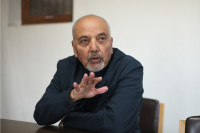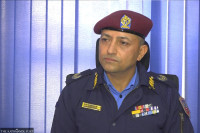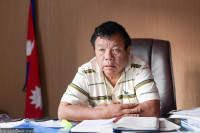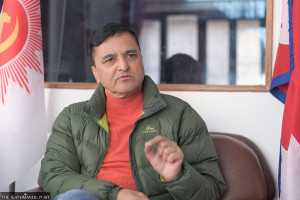Interviews
‘Parties lack willpower to ensure proportional representation of marginalised communities’
Executive chairperson of the Samata Foundation, Pradip Pariyar, who advocates the rights of marginalised people in Nepal, currently leads the #DalitLivesMatter movement in the country.
Tika R Pradhan
Executive chairperson of the Samata Foundation, Pradip Pariyar, who advocates the rights of marginalised people in Nepal, currently leads the #DalitLivesMatter movement in the country. He was one of the young global leaders selected for the class of the World Economic Forum in 2020. Pariyar spoke to the Post’s Tika R Pradhan on a host of issues including the representation of Dalits and marginalised communities, the role of youths in changing society and the report of the National Inclusion Commission suggesting an end to the reservation policy in Nepal. Excerpts:
How do you observe Dalit representation in Parliament and state agencies?
Nepal’s constitution stipulates that all state mechanisms will be inclusive—ensuring proportional representation of all groups, but the governments, past and present, have failed to draft the necessary laws to ensure such representation. One election law has ensured the representation of Dalit women in all wards of the local units and this is the only provision that political parties implement. The leaders in the state mechanism do not ensure the representation of the marginalised communities as per the spirit of the constitution. Firstly, they haven’t drafted laws necessary to ensure proper representation and secondly, they don’t implement the existing laws.
There is a history of political parties being dishonest when it comes to representation. From the decade-long Maoist insurgency to the 2006 people’s movement to the Madhesh, Tharu, and Dalit movements, it was the political parties that brought people to the streets with promises of representation in Parliament and state agencies. But after the political changes brought about by these movements, the parties did not keep their word to the marginalised.
We have spoken to almost all political leaders in the seven provinces and those in the Capital. Most of them said candidates from marginalised communities do not win the polls. I was surprised by this argument because there are thousands of candidates in the fray in each poll and it’s not just candidates from marginalised communities who lose the polls.
It is widely believed in political circles that women, Dalits, Tharus or Janajatis and those from financially weak backgrounds cannot win the polls and this sentiment allows politicians to engage in fear mongering. They create an impression that elections are not for the common people. Rather than uplifting members of the marginalised communities to strengthen democracy, political parties send out messages that are discouraging for aspiring candidates.
Only mandatory provisions written in the laws, including the 33 percent representation of women and a certain percent allocated for different groups in the proportional representation system, are followed by political parties. If there were no such provisions, political parties would not ensure any representation.
The election law has mandated the representation of Dalits but it has not mentioned that their representation should be equally distributed among men and women. Therefore, parties have been selecting women only to fulfil the women’s quota depriving the representation of capable male members of those communities.
Although the representation of Dalit women in itself is encouraging progress, the law is not clear on the representation of Dalit men or Muslim men and other male members of the marginalised communities.
If this continues, people will understand that the proportional election system is only meant to ensure 33 percent representation of women.
In my observation, political parties have no willpower to ensure proportional representation of the marginalised communities. It’s disheartening to know that the Maoist party raised the issue of proportional representation but failed to put it into practice.
These issues highlight the mindset of the political leaders in that they won’t go for inclusiveness unless there are mandatory legal provisions in place.
Although there is a mandatory provision for Dalit women as ward members, political parties failed to field Dalit women candidates in several places. Why?
This goes on to show that the political parties haven’t reached out to the entire Dalit population. Yes, there are some wards where there are no Dalit settlements and because of the mandatory provision, the seats allocated to them remained vacant for that term. But in places like Kathmandu and Bhaktapur, it was sheer negligence of the political parties. More than 150 positions of Dalit women ward members remain vacant across the country.
Have the political movements and other social movements brought any positive changes in curbing social discrimination and increasing the representation of the marginalised?
After democracy, Dalits are getting opportunities to speak, write and get an education and raise their voice. These are very important achievements.
During the constitution drafting process, the Dalit wings of all parties parties came together and discussed the common agenda to be guaranteed in the constitution. This gave birth to Articles 24 and 40 of the constitution which ensure education, health, social security and traditional occupations to the marginalised. These positive changes came about due to the Dalit movements and democratic movements.
In 2011, the Caste-Based Discrimination and Untouchability (Offence and Punishment) Act was drafted. The Act was important because it criminalised caste-based discrimination. After the people’s movement of 2006, we got the reservation policy due to which we have around two percent representation of Dalits in bureaucracy. Earlier the representation was negligible. However, there is still no representation of Dalits at the policy level. Also, reservation policy in the army and police has also brought positive changes. With this, there is a distant ray of hope among these communities that they can be a part of various sectors of the state.
However, there are also challenges in eradicating caste-based discrimination as seen in the Rukum incident, Angira Pasi case and the recent case in Bajura where the ward chair beat up a Dalit man for entering a temple. If there were any positives in these incidents it is that Dalits have started to retaliate against such inhuman treatments meted out to them.
You have said that the political parties are not honest. What could be the role of pressure groups to make them accountable or how can the parties be made accountable?
To make political parties accountable and honest, their sister wings in the marginalised groups have a crucial role to play since they have spent all their lives and efforts in their respective parties. They have the right to question and challenge their leadership. If they cannot challenge their political leadership on caste-based atrocities then there is no point in being a member of that party. I also understand that it could be difficult for them to raise their voices while staying in the party because in the political scene only those who cater to the whims and fancies of the political leadership can climb the party ranks. This form of cronyism needs to be checked. This is where the role of organisations like ours (Samata Foundation) comes into play with us involving Dalit members of political parties in capacity building; giving them wider exposure and bringing them together and providing them with research findings.
In 2019, we brought Dalit members of political parties together and asked how they were working. Then there were no ministers from the Dalit community in the seven provincial governments. After our discussions, Province 1 got a Dalit state minister. The other provinces also followed suit except for the Madhesh Province.
But how can the Dalit leaders convince our top leaders who don’t even listen to powerful leaders of their parties?
Dalits and marginalised groups are also vote banks for political parties. Dalits account for 13.8 percent of the total population and that kind of number can sway the polls. Dalit leaders must convince their leadership based on their voting strength. If Dalit issues are not properly addressed they must challenge the leadership.
What about the overall representation in the state mechanism and Parliament?
The issue of overall representation is not encouraging. If we look at bureaucracy, Dalit representation is only around two percent out although Dalits comprise 13.8 percent of the national population. In the National Assembly, among the 59 members only seven are Dalits; only 19 members of the 275-strong House of Representatives were Dalits. If we talk about proportional representation, there must be 38 Dalit members in the lower house and at least eight in the upper house.
In the seven provincial assemblies, there are only 33 Dalit members among the total 550 but there must be 76 members for proportional representation.
During the last polls for the House of Representatives, there were only three Dalit candidates contesting—UML leaders Chhabilal Bishwokarma from Rupandehi and Jagat Sunar from Kaski, and Maoist Centre’s Maheshwar Gahatraj. Interestingly they all won the polls. However, the prospects of Dalit candidates is not encouraging as political parties are not committed to increasing Dalit representations.
What is your observation of the recent report of the National Inclusion Commission that talks about ending the reservation policy?
What I feel is that this country is mine but the state is not, because there is no diversity in the state. If you read the name plates inside Singha Durbar and the panellists and speakers gracing the podiums in Kathmandu, you won’t feel this state is yours. One of the prime examples of how the organs of the state have not properly implemented Nepal’s constitution is the recent report of the National Inclusion Commission. Prior to that—around one and a half years ago—the Public Service Commission announced vacancies for around 9,000 positions at the local level ignoring the reservation policy. If they had followed the reservation policy, at least 1,000 Dalits could have gotten jobs. That was when they started denying us the reservations quota. Following that the Supreme Court issued a verdict stating that only the “privileged” among the marginalised communities in Nepal have got opportunities thereby creating a creamy top layer.
Also, it is an irony that the commission itself is not inclusive. Maybe they are testing the waters to see if they can get away with it. They cannot come to any conclusion on reservations without reviewing the reservation arrangements. If they do, then the commission should say they only cater to the interests of Khas-Arya. Their recent report goes against the spirit of the constitution which talks about proportional representation and inclusiveness.
There is a serious need to study the over-representation of Khas-Arya in Nepali society and why they are over-represented. Is that because they know the Nepali language and other communities are not given equal opportunities or the system is designed in such a way that only they can pass the opportunities on to others? So before we get into the marginalized communities’ representation, the overrepresentation of the Khas-Arya community must be studied.
In Nepal, Muslims, Dalits and Tharus are underrepresented, so how can they say this state is theirs?
The most important issue is who is making the rules of the game. When people question whether the marginalised candidates are capable, they must realise that the candidates have fulfilled the basic rule of the game—the criteria to become political candidates.
Why do you think Dalit and Janajati movements are gradually becoming ineffective?
Firstly, all the marginalised communities like Dalit, Janajati, and women have contributed to all movements. Their roles are crucial in all the movements of Nepal whether that is the Maoist people’s war, the Madhesh movement or the people’s movements. All those who participated in these movements thought their demands of representation would be met but that did not happen. They didn’t get fair representation in state mechanisms. The communities who were capable of sharing resources didn’t want to share them with the marginalised communities once the movements were over.
Now with the new developments to curb their rights, the marginalised communities should have raised their voice against it but they have not been able to do so. The major reason is some of those leaders within the marginalised communities received the benefits and failed to speak for the communities.
Do you think a change in leadership could help improve representation of marginalised groups?
In South Asian countries the definition of leadership is synonymous with someone who has a huge amount of money, can deploy more goons and those who have more people hovering around them. This must change. Only those who are honest, have integrity and will to serve the people should be in leadership positions. Also, the youth leaders have failed to challenge their top leaders since the former tend to wait for their turn and over time become complicit in corrupt leaders’ shenanigans.
What should the young generation do to bring positive change to society?
Dalit and non-Dalit youths must come out of their comfort zones. Problems cannot be solved by simply criticising the previous generations. We need to make some efforts by challenging our existing leadership and doing positive work to change our society.




 13.12°C Kathmandu
13.12°C Kathmandu













